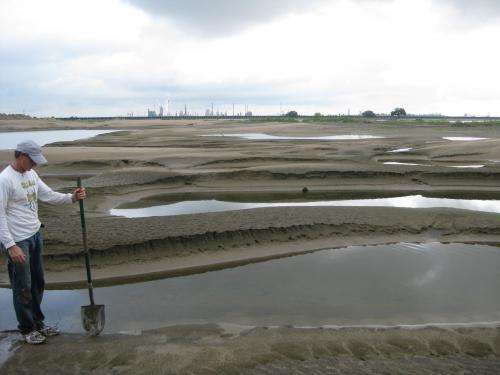April 21, 2014 report
Sampling study suggests Mississippi River has ample sand to prevent delta land loss

(Phys.org) —A pair of researchers has found, via sand sampling data, that the common perception that too little sand is being carried down the Mississippi River to replenish depleted loads is incorrect. In their study, published in Nature Geoscience, Jeffrey Nittrouer, of Rice University and Enrica Viparelli of the University of South Carolina describe how they analyzed sand sample data from two locations downstream from the Missouri River, and found that reduced sand loads due to damming has been made up for with increased river bottom erosion.
For many years, scientists and many people who live on or near the Mississippi River delta have blamed damming of the Missouri River back in the 1950's for the extensive permanent flooding that has occurred in the delta since, dubbed by the researchers a "catastrophic drowning." To stop the drowning, geologists and other scientists have suggested building back parts of the flooded areas using sand or other sediments carried in the river through the area and deposited into the Gulf of Mexico. The problem with that approach was that it was believed too little sand was being carried to make such an engineering project viable. The researchers in this new effort suggest that there is indeed enough sand in the river, and should be for at least six centuries.
To find out just how much sand was being lost to damming, the researchers pulled records from databases compiled over the past forty years, for two locations downstream of where the Missouri and Mississippi join. In analyzing the data, they were surprised to discover that though the amount of general sediment was low, the amount of sand was not, and has not been since the construction of the dams—this despite the fact that the data showed that the dams pulled approximately 75 percent of the sand from the Missouri River. Further research revealed that the reason sand levels remained high was because it was being pulled from the bottom of the river, causing the Mississippi River to grow deeper.

Furthermore, based on an analysis of the river bottom, the two researchers predict that sand levels should remain nearly steady (just a 17 percent reduction) for approximately 600 years—clearly more than enough time to embark on efforts to restore flooded lands and prevent future drowning of the delta.
More information: "Sand as a stable and sustainable resource for nourishing the Mississippi River delta." Jeffrey A. Nittrouer, Enrica Viparelli. Nature Geoscience (2014) DOI: 10.1038/ngeo2142 . Received 17 May 2013 Accepted 14 March 2014 Published online 20 April 2014
Abstract
The Mississippi River delta is undergoing a catastrophic drowning, whereby 5,000 km2 of low-lying wetlands have converted to open water over at least the past eight decades1, as a result of many anthropogenic and natural factors. Continued net land loss has been thought inevitable due to a decline in the load of total suspended sediment—both sand and mud—carried by the river. However, sand—which accounts for ∼50–70% of modern and ancient Mississippi delta deposits but comprises only ∼20% of the sampled portion of the total load—could be more important than mud for subaerial delta growth5. Historically, half of the Mississippi River sediment load is supplied by the Missouri River3. Here we analyse suspended sediment load data from two locations downstream from the lowest Missouri River dam to show that the measured sand load in the lower 1,100 km of the Mississippi River has not significantly diminished since dam construction. A one-dimensional numerical model of river morphodynamics predicts that the sand load feeding the delta will decrease only gradually over the next several centuries, with an estimated decline from current values of no more than about 17% within the coming six centuries. We conclude that the lower Mississippi River channel holds a significant reservoir of sand that is available to replenish diminished loads via bed scour and substantially mitigate land loss.
Journal information: Nature Geoscience
© 2014 Phys.org



















